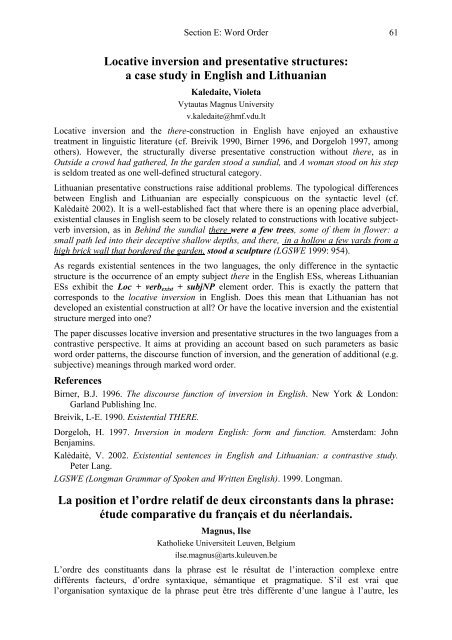Relativism and Universalism in Linguistics - Fachbereich 10 ...
Relativism and Universalism in Linguistics - Fachbereich 10 ...
Relativism and Universalism in Linguistics - Fachbereich 10 ...
You also want an ePaper? Increase the reach of your titles
YUMPU automatically turns print PDFs into web optimized ePapers that Google loves.
Section E: Word Order 61<br />
Locative <strong>in</strong>version <strong>and</strong> presentative structures:<br />
a case study <strong>in</strong> English <strong>and</strong> Lithuanian<br />
Kaledaite, Violeta<br />
Vytautas Magnus University<br />
v.kaledaite@hmf.vdu.lt<br />
Locative <strong>in</strong>version <strong>and</strong> the there-construction <strong>in</strong> English have enjoyed an exhaustive<br />
treatment <strong>in</strong> l<strong>in</strong>guistic literature (cf. Breivik 1990, Birner 1996, <strong>and</strong> Dorgeloh 1997, among<br />
others). However, the structurally diverse presentative construction without there, as <strong>in</strong><br />
Outside a crowd had gathered, In the garden stood a sundial, <strong>and</strong> A woman stood on his step<br />
is seldom treated as one well-def<strong>in</strong>ed structural category.<br />
Lithuanian presentative constructions raise additional problems. The typological differences<br />
between English <strong>and</strong> Lithuanian are especially conspicuous on the syntactic level (cf.<br />
Kalėdaitė 2002). It is a well-established fact that where there is an open<strong>in</strong>g place adverbial,<br />
existential clauses <strong>in</strong> English seem to be closely related to constructions with locative subjectverb<br />
<strong>in</strong>version, as <strong>in</strong> Beh<strong>in</strong>d the sundial there were a few trees, some of them <strong>in</strong> flower: a<br />
small path led <strong>in</strong>to their deceptive shallow depths, <strong>and</strong> there, <strong>in</strong> a hollow a few yards from a<br />
high brick wall that bordered the garden, stood a sculpture (LGSWE 1999: 954).<br />
As regards existential sentences <strong>in</strong> the two languages, the only difference <strong>in</strong> the syntactic<br />
structure is the occurrence of an empty subject there <strong>in</strong> the English ESs, whereas Lithuanian<br />
ESs exhibit the Loc + verbexist + subjNP element order. This is exactly the pattern that<br />
corresponds to the locative <strong>in</strong>version <strong>in</strong> English. Does this mean that Lithuanian has not<br />
developed an existential construction at all? Or have the locative <strong>in</strong>version <strong>and</strong> the existential<br />
structure merged <strong>in</strong>to one?<br />
The paper discusses locative <strong>in</strong>version <strong>and</strong> presentative structures <strong>in</strong> the two languages from a<br />
contrastive perspective. It aims at provid<strong>in</strong>g an account based on such parameters as basic<br />
word order patterns, the discourse function of <strong>in</strong>version, <strong>and</strong> the generation of additional (e.g.<br />
subjective) mean<strong>in</strong>gs through marked word order.<br />
References<br />
Birner, B.J. 1996. The discourse function of <strong>in</strong>version <strong>in</strong> English. New York & London:<br />
Garl<strong>and</strong> Publish<strong>in</strong>g Inc.<br />
Breivik, L-E. 1990. Existential THERE.<br />
Dorgeloh, H. 1997. Inversion <strong>in</strong> modern English: form <strong>and</strong> function. Amsterdam: John<br />
Benjam<strong>in</strong>s.<br />
Kalėdaitė, V. 2002. Existential sentences <strong>in</strong> English <strong>and</strong> Lithuanian: a contrastive study.<br />
Peter Lang.<br />
LGSWE (Longman Grammar of Spoken <strong>and</strong> Written English). 1999. Longman.<br />
La position et l’ordre relatif de deux circonstants dans la phrase:<br />
étude comparative du français et du néerl<strong>and</strong>ais.<br />
Magnus, Ilse<br />
Katholieke Universiteit Leuven, Belgium<br />
ilse.magnus@arts.kuleuven.be<br />
L’ordre des constituants dans la phrase est le résultat de l’<strong>in</strong>teraction complexe entre<br />
différents facteurs, d’ordre syntaxique, sémantique et pragmatique. S’il est vrai que<br />
l’organisation syntaxique de la phrase peut être très différente d’une langue à l’autre, les

















